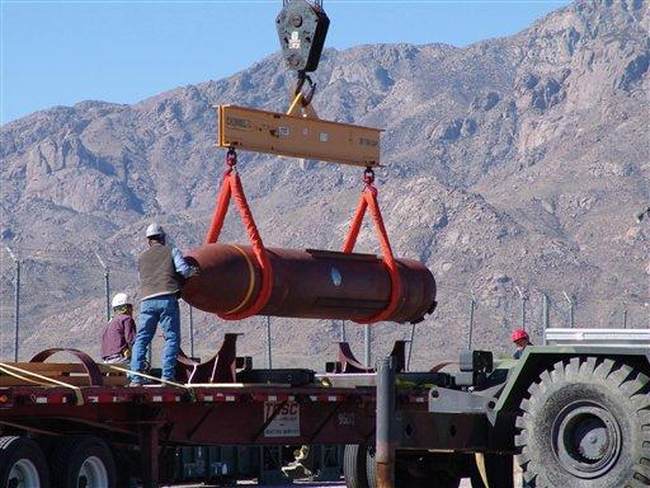
“Bunker buster” bombs are not all the same, even if they all share the same name.
Israel can deploy “bunker buster” bombs, but only of the 2000 lb variety. These can be very useful to strike some buried targets, particularly tunnels and certain reinforced bunkers. But the technology dates back to the 1970s, and already by 1990, the defensive capability of bunkers had outstripped the ability of existing weapons to reliably destroy them.
That’s why, during the buildup to the Gulf War, a new bunker buster was developed in a rush project, resulting in the laser-guided GBU-28, which was deployed with quite satisfying results during the war.
But technology marches on; massively stronger concrete has been developed, and bunkers are being dug deeper, so in response, the United States developed the GPS-guided Massive Ordinnce Penetrator, a 30,000 lb bomb that can only be deployed from the weapons bay of a B-2 bomber, which can carry two of them.
HOW A BUNKER BUSTER BOMB WORKS:
Useful educational video to elaborate on what Iran’s Nuclear facilities (if any) are facing.This is why it’s dangerous to say “Death To America”. pic.twitter.com/2JdUnjDW6H
— BLACK DUMPLING™ (@blackdumpling58) June 18, 2025
Its capabilities are mind (and bunker) blowing. It can penetrate 200 feet of rock, delivering an explosive punch to anything buried deep underground. There is nothing like it, and it is widely believed that no airplane or ballistic missile could deliver a weapon with similar capabilities except the B-2.
The B-2 can drop the equivalent of 5 Ford F-350s onto a target.
The bomb shown here is a GBU 57 bunker buster weighing in at a robust 30,000lbs.
Not something you want to be on the wrong side of.pic.twitter.com/NnUFV8VVKE
— 🐺 (@LeighWolf) June 17, 2025
This is why there is so much talk about Trump deploying the B-2 to take out Iran’s Fordo nuclear enrichment facility. It is buried so deeply underground that it would take multiple strikes from the MOP to reach the production facilities. In other words, only the United States can do the job of significantly delaying by more than a year Iran’s capacity to build a nuclear weapon–at least supposedly.
The 15-ton mega bomb which could destroy Iran’s last nuclear facility – and why Israel can’t deliver it https://t.co/sbTl8xQplL pic.twitter.com/lVootSd99g
— New York Post (@nypost) June 17, 2025
Even with Israel’s massive strikes and assassination of Iran’s top nuclear scientists, Iran will have the capability to restart its program relatively promptly, should it so choose. And while doing so would be extremely risky, given Israel’s demonstrated capability to strike at will, it also has an even greater incentive to develop a sufficient deterrent to Israeli attacks.
But what if Israel could duplicate the US capability, or at least come close enough for government work?
Could Israeli C-130s Drop GBU-57 Massive Ordnance Penetrator Bunker Busters?
B-2s are the only aircraft that can employ MOPs to get at Iran’s deepest facilities, but C-130s may be a viable option with a similar weapon.https://t.co/SRncJLMEBV
— Tyler Rogoway (@Aviation_Intel) June 19, 2025
Tyler Rogoway of The War Zone suggests a possibility. Instead of using stealth bombers, which have the advantage of being able to penetrate defended airspace to deliver their ordnance, could Israel use cargo aircraft to deliver something akin to the Massive Ordnance Penetrator?
Making the aerial threat conditions anemic enough so that a C-130 can survive reliably deep into Iranian territory would be relevant for going after nuclear targets that standard aerial weaponry cannot reach. In the past, we have detailed how a ground assault would likely be necessary for this task if Israel had to go it alone. The IDF has certainly shown it’s prepared for such operations, but that is still an extremely risky endeavor. So, what if Israel’s C-130s could drop GBU-57 MOPs, or an Israeli weapon very similar to it, on these targets instead of B-2s?
There is certainly a precedent for C-130s dropping absolutely massive bombs out of their cargo holds, both old and new. The BLU-82 Daisy Cutter was dropped by C-130, primarily to clear landing zones, during the Vietnam War. A modernized fuel-air weapon known as the GBU-43 Mother Of All Bombs (MOAB) is in service today, and it was used with devastating results in Afghanistan in 2017. So why not a super-heavy penetrator?
There is plenty of precedent for using cargo aircraft to deliver ordnance, and the United States currently has palletized munitions that can be dropped right out the back of our C-130s.
Obviously you can’t palletize bunker busters. They aren’t cruise missiles, but you could still drop a weapon the size of the MOP out the rear cargo door of a C-130 without breaking a sweat. The aircraft can carry much more weight than 30,000 lbs, and while none of Israel’s cargo planes could carry more than one, they could carry one without any problem.
One major area where the C-130 would be at a disadvantage to the B-2, beyond its survivability and ability to carry two MOPs at once, is its speed and altitude. The Hercules flies substantially lower and slower than the B-2, which would have an impact on the weapon’s overall impact force, and likely substantially so. A C-130 dropping the same weapon at 25,000 feet and 250 miles per hour will result in significantly less kinetic force of impact than a B-2 dropping the weapon at 50,000 feet and 500 miles per hour. This is a big deal for a munition that is meant to burrow down as deeply as possible into a mountain and detonate.
Even if a C-130 carried the exact same weapon, it would not have the same capabilities of the MOP because much of the energy necessary to penetrate the ground or concrete layer comes from a gravity assist. Drop 30,000 lbs from 50,000 feet with an initial speed of 500 miles per hour, and you have a nice kinetic boost from all that initial energy imparted to the weapon. Starting out half as fast and from half as high and much less energy is available to penetrate any obstacles.
Re-upping this bunker-buster graphic: Fordow sits under hundreds of feet of rock. Only U.S. GBU-57s dig that deep. Taking it out, plus Iran’s 60% stockpile, advanced centrifuges, Arak, and supply chains, is how to get a 12-mo nuclear breakout buffer. SEAD buys the corridor; only… https://t.co/c0FAEeUR5X pic.twitter.com/6A0bIJYzdm
— mace (@ajquery) June 15, 2025
But nobody expects only one bomb to be deployed in any case. While, as far as I know, nobody has tried to dig a massive hole into the ground by serially dropping MOPs into the same hole, in theory this could do the trick. Reality may not cooperate with theory, but there is only one way to find out, and it may not require actually reaching the actual tunnels to do enough damage to render the site unusable.
Whether Israel has this capability is unknown, and as far as I know only Rogaway has suggested the possibility. After all, everybody assumes that Israel being able to dominate Iran’s airspace so completely was unexpected, so everybody assumed that only a stealth aircraft could do this sort of job. Even a severely degraded air defense system would have a decent shot at taking out an aircraft that is limited to flying low and slow.
But things are different than expected, and if Israel has the capability to produce a MOP-like weapon, it also now has the capacity to deliver it.
Intriguing.












